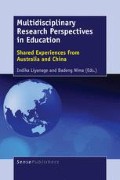Abstract
In modern China, traditional minority ethnic groups and cultures are threatened by rapid and extensive economic and social changes that follow modernization. The ancient ethnic group of Qiang people were recorded by the oracles of the Shang Dynasty and contributed to the emergence of other ethnic groups in Chinese history, including the now dominant Han people (Fei, 1999). Over their long history, Qiang people have developed a unique culture including oral literature, festivals, music and dance, residential architecture, arts and crafts, garments, diet, and so on.
Access this chapter
Tax calculation will be finalised at checkout
Purchases are for personal use only
Preview
Unable to display preview. Download preview PDF.
References
Fei, X. T. (1999). The pattern of diversity in unity of the Chinese nation. Beijing: Minzu University of China Press. [Mandarin]
Fei, X. T. (2000). Review and experience of reconstruction of sociology and anthropology. Social Sciences in China, 21(1), 37–51. [Mandarin]
Feng, J. C. (2008). Ecological culture is the core content of human civilization. Journal of Land Today, 6(10), 18–19. [Mandarin]
Feng, J. C., & Xiang, Y. J. (2008). The student reader of Qiang culture. Beijing: Zhong Hua Press. [Mandarin]
Green, A. (2004). Education, globalization and the nation state. London: Palgrave Macmillan.
Leading Group Office of Popularizing the Qiang Language of Maoxian County in Sichuan Province. (2002). Compilation of the research data of Qiang language. Maoxian: Leading Group Office of Popularizing the Qiang Language of Maoxian County in Sichuan Province. [Mandarin]
The State Council of the People’s Republic of China. (2008). Plans for restoration and reconstruction of the Wenchuan area following the 2008 earthquake. Retrieved from http://www.gov.cn/zwgk/2008-09/23/content_1103686.htm [Mandarin]
UNESCO. (1995).Our creative diversity: Report of the World Commission on Culture and Development. Paris: UNESCO Publishing.
Wu, D. C., Zhang, C. S., & Zhu, S. L. (2011). Educational development history of the Qiang ethnic group. Beijing: The Commercial Press. [Mandarin]
Zhu, S. L., & Zhao, H. D. (2015). Study on the current situation and countermeasures of the teachers’ professional quality in primary and middle schools in Qiang area in China. Cross-Cultural Communication, 11(7), 32–34. doi: 10.3968/%25x
Author information
Authors and Affiliations
Editor information
Editors and Affiliations
Rights and permissions
Copyright information
© 2016 Sense Publishers
About this chapter
Cite this chapter
Sheng-Li, Z. (2016). Protecting Traditional Cultures in China. In: Liyanage, I., Nima, B. (eds) Multidisciplinary Research Perspectives in Education. SensePublishers, Rotterdam. https://doi.org/10.1007/978-94-6300-615-6_22
Download citation
DOI: https://doi.org/10.1007/978-94-6300-615-6_22
Publisher Name: SensePublishers, Rotterdam
Online ISBN: 978-94-6300-615-6
eBook Packages: EducationEducation (R0)

